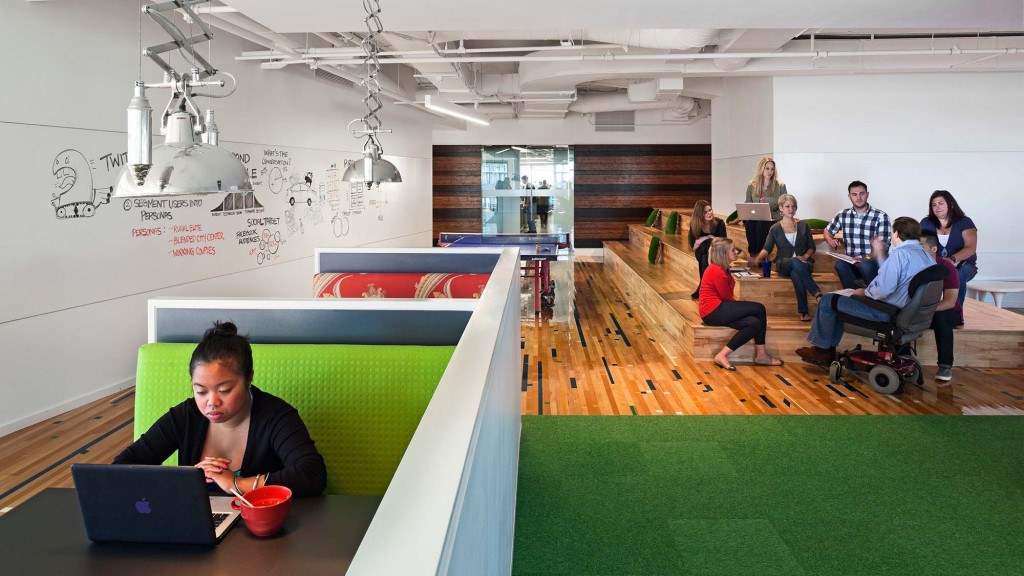Do top-performing companies work differently?
The 2008 U.S. & U.K. Workplace Surveys
What We Did
Note: this report is part of an ongoing series of research on the workplace - view the latest U.S. Workplace Survey and UK Workplace Survey
As a follow-up to inaugural Workplace Surveys conducted in 2005 and 2006, we conducted two parallel surveys to further understand how the physical work environment connects to business drivers and outcomes. In the United States, we surveyed a random sample of 900 full-time, in-office workers—defined as workers who spend most of their time working at a primary, assigned location. We also asked the same questions of an additional 300 office workers in the United Kingdom. Respondents represented all staff levels and worked in industries including banking, finance, insurance, technology, Internet, telecom, consumer products, retail, legal, accounting, consulting, energy, media, creative, entertainment, and not-for-profit associations.
We designed our survey questions to place insights about the physical work environment within a larger business and organizational context. Our focus areas included an evaluation of company business success based on eight established indicators: leadership in the industry; financial strength; creation of quality products or services; innovation; promotion of work/life balance; superior management capabilities; ability to attract and retain talent; and responsibility to community and the environment. Questions also captured profit and revenue growth; employee perception of the workplace in relation to company values, brand, and performance; and an evaluation of the physical workplace on a number of performance factors.
The Context
In a knowledge economy, business success flows from intangible assets such as ideas, information, and expertise. Employee engagement and performance are significant drivers of business productivity and success, yet postindustrial metrics fall short of offering the insights that companies need to gain a competitive edge in a global business environment. An understanding of the connection between workplace design and business performance was lacking; our survey sought to fill that gap.
The Results
Our research established new measures of performance that begin to quantify the power of people and place to drive profit. The physical work environment is an asset with a specific and quantifiable impact on business success. Results showed that top-performing companies (those with higher profits, better employee engagement, and stronger market and brand position) have significantly higher-performing work environments than average companies. Employees at top-performing companies ranked their workplaces higher in quality and effectiveness; are more satisfied with their workplaces; and more highly value all four work modes investigated in our research. The bottom line is that effective workplace design directly correlates to improved business performance.
The data also provided a baseline for us to understand how and where employees are spending their in-office time, and how that usage varies based on company performance. Across the surveys, focus dominates employees’ time—averaging 48% of time for US respondents and 59% of time for UK respondents—with collaboration time taking the second spot. Socializing and learning take up comparatively less of the workers’ average workweek. Interestingly, employees at top-performing companies spend comparatively more time collaborating and less time focusing than their average peers—though it is worth noting that even for these respondents, focus time still dominates their day.
What This Means
Four work modes—focus, collaborate, learn, and socialize—are the foundation of an effective knowledge workplace. Knowledge economy companies realize a competitive advantage through the creation of ideas. Knowledge work is a composite of individual and collective work activities that are all important to work effectiveness.
Success in a knowledge economy means working differently. We found that employees at top-performing companies not only spend more time collaborating and learning than those at average companies, they consider that time more critical to job success than do their peers at average companies.
Top-performing companies design their workplaces to support all four work modes. Our findings clearly show that top-performing companies have more effective workplaces. These workplaces are designed to allow people to spend higher-quality time in the work modes that matter most to their job success.
What’s Next?
We have used the results of this research to develop the benchmarks contained in Gensler’s Workplace Performance Index® (WPI) survey tool, as a starting point for client discussions, and to inform the implementation of design strategy on numerous projects. The findings also informed subsequent workplace studies and allowed us to identify and more deeply explore issues that emerge over time, including the outsize impact of focus work on individual and collective performance.
Learn More
Team
James Williamson, Andreas Andreou, Christine Barber, Erik Lucken, Elizabeth Riordan, D/R Added Value (research consultant)
Year Completed
2008
Comments or ideas for further questions we should investigate?
